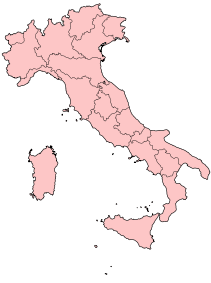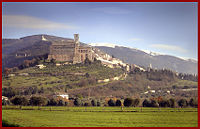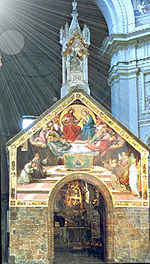Assisi
Comune di Assisi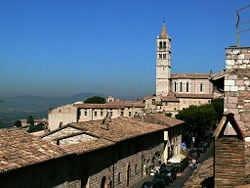
| |
|---|---|
 Municipal coat of arms | |
| Country | |
| Region | Umbria |
| Province | Perugia (PG) |
| Mayor | Claudio Ricci (since May 2006) |
| Elevation | 424 m (1,391 ft) |
| Area | 186 km² (72 sq mi) |
| Population (as of December 31, 2004) | |
|  - Total | 26,196 |
|  - Density | 141/km² (365/sq mi) |
| Time zone | CET, UTC+1 |
| Coordinates | 43¬į04‚Ä≤N 12¬į37‚Ä≤E |
| Gentilic | Assisani |
| Dialing code | 075 |
| Postal code | 06081 |
| Frazioni | see list |
| Patron | St. Rufinus |
|  - Day | August 12 |
| Website: www.comune.assisi.pg.it | |
Assisi is a small city in the Perugia province of the Umbria region of Italy. It is situated on the western flank of Monte Subasio at an elevation of 1,300 feet (400 meters) and overlooks the valleys of the Topino and Chiascio rivers. In 2004 its population was recorded as 26,196.
Assisi is most well-known as the birthplace of Saint Francis, the founder of the Franciscan order and one of the most popular Catholic saints, and his contemporary, St. Clare (Chiara d'Offreducci), the founder of the Poor Clares. Saint Gabriel of Our Lady of Sorrows was also born in Assisi, in 1838.
Early Romans built the flourishing municipium Asisium on a series of terraces on Monte Subasio. These remains are still seen in Assisi today in the form of city walls, the forum (now Piazza del Comune), a theatre, an amphitheatre and the Temple of Minerva (now the Church of Santa Maria sopra Minerva). However, Assisi's main attraction is the thirteenth-century Basilica di San Francesco, which contains sacred relics of Francis and beautiful early Renaissance frescoes of his life.
| Assisi, the Basilica of San Francesco and Other Franciscan Sites* | |
|---|---|
| UNESCO World Heritage Site | |
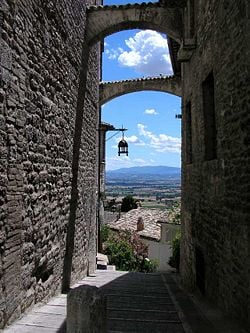
| |
| State Party | |
| Type | Cultural |
| Criteria | i, ii, iii, iv, vi |
| Reference | 990 |
| Region** | Europe and North America |
| Inscription history | |
| Inscription | 2000  (24th Session) |
| * Name as inscribed on World Heritage List. ** Region as classified by UNESCO. | |
UNESCO designated "Assisi, the Basilica of San Francesco and Other Franciscan Sites" a World Heritage Site in the year 2000, describing it as "an ensemble of masterpieces of human creative genius... which have made it a fundamental reference for art history in Europe and in the world." UNESCO also recognized, among other things, "the interchange of artistic and spiritual message of the Franciscan Order...in art and architecture in the world."
Assisi, a beautiful medieval town, draws between four and five million visitors a year, who come to view its historic buildings and the nature which inspired such people as St. Francis, St. Clare, and others who promoted the universal message of peace and tolerance towards other religions or beliefs.
History
Around 1000 B.C.E. a wave of immigrants settled in the upper Tiber valley as far as the Adriatic Sea and also in the neighborhood of Assisi. These were the Umbrians, living in small fortified settlements on high ground. From 450 B.C.E. these settlements were gradually taken over by the Etruscans. The Romans took control of central Italy by the Battle of Sentinum in 295 B.C.E. They built the flourishing municipium Asisium on a series of terraces on Mount Subasio. Remains from these Roman times can still be found in Assisi in the form of city walls, the forum (now Piazza del Comune), a theatre, an amphitheatre and the Temple of Minerva (now transformed into the Church of Santa Maria sopra Minerva).
In 238 C.E. Assisi was converted to Christianity by bishop Rufino, who was martyred at Costano. According to tradition, his remains rest in the Cathedral Church of San Rufino in Assisi.
The Ostrogoths of king Totila destroyed most of the town in 545. Assisi then came under the rule of the Lombards and later the Frankish Duchy of Spoleto.
The thriving city became an independent Ghibelline commune in the eleventth century. Constantly struggling with the Guelph Perugia, it was during one of those battles, the battle at Ponte San Giovanni, that Francesco di Bernardone, (Saint Francis of Assisi), was taken prisoner, setting in motion the events that eventually led him to live as a beggar, renounce the world and establish the Order of Friars Minor.
The Rocca Maggiore, the imperial fortress on top of the hill above the city, was plundered by the people in 1189, but rebuilt in 1367 on orders of the papal delegate, cardinal Gil de Albornoz.
The city, which had remained within the confines of the Roman walls, began to expand outside these walls in the thirteenth century. In this period the city was under papal jurisdiction.
In the beginning, Assisi fell under the rule of Perugia and later under several despots, such as the soldier of fortune Biordo Michelotti, Gian Galeazzo Visconti, duke of Milan, Francesco I Sforza, another duke of Milan, Jacopo Piccinino and Federico II da Montefeltro, lord of Urbino. The city went into a deep decline through the plague of the Black death in 1348 C.E.
The city came again under papal jurisdiction under the rule of Pope Pius II (1458-1464).
In 1569 construction was begun on the Basilica of Santa Maria degli Angeli. During the renaissance and later centuries, the city continued to develop peacefully, attested by the 17th century palaces of the Bernabei and Giacobetti.
Now the site of many a pilgrimage, Assisi is linked in legend with its native son, St. Francis. The gentle saint founded the Franciscan order and shares honors with St. Catherine of Siena as the patron saint of Italy. He is remembered by many, even non-Christians, as a lover of nature (his preaching to an audience of birds is one of the legends of his life).
Assisi was hit by the devastating twin earthquakes that shook Umbria in 1997, but the recovery and restoration have been remarkable, although much remains to be done. Massive damage was caused to many historical sites, but the major attraction, the Basilica di San Francesco, reopened less than two years later.
Pilgrimage
Francis of Assisi from early times was a well-respected and venerated saint within the Catholic Church. The city's most notable landmark is the Basilica of San Francesco, the construction of which began two years after his death and was completed in 1253. This two-story basilica consists of an upper church and a lower church. The crypt in the lower church was added in 1818 when the tomb of St. Francis was opened.
The late seventeenth century saw a growth of interest in the life and work of St. Francis outside of the Catholic confines. An International Society of Franciscan Studies was founded at Assisi in 1902, focused on research and critical studies of Francis' life and works.
By the mid-1400s pilgrims were flocking to Assisi from all parts of Europe and today the walled medieval town and its grand basilica are among the most visited of Christian shrines.
The city is a pilgrimage destination not only for Catholics, but inclusive of a broader range of scholars and the curious.
Main sights
Churches
- The Basilica of San Francesco d'Assisi, honoring St. Francis, is a World Heritage Site and one of Italy's foremost monuments. The Franciscan monastery, il Sacro Convento, and the lower and upper church (Basilica inferiore e superiore) of St Francis were begun immediately after his canonization in 1228, and completed in 1253. The short period of its construction, rare for a church of this size, is often explained as a measure of the great love that the people of the time had for St. Francis. The lower church has frescos by renowned late-medieval artists Cimabue and Giotto; in the Upper church are frescos of scenes in the life of St. Francis, previously ascribed to Giotto but now thought to have been done by artists of the circle of Pietro Cavallini of Rome. The Basilica was badly damaged by the earthquake of September 26, 1997. Part of the vault collapsed, killing four people inside the church and carrying with it a fresco by Cimabue. The edifice and was closed for two years for restoration.
- Santa Maria Maggiore (St. Mary the Greater), the earliest extant church.
- The Cathedral of San Rufino (Saint Rufinus), with a Romanesque facade with three rose windows and a sixteenth century interior; part of it is built on a Roman cistern. According to legend, Rufinus of Assisi (sometimes Rufino) was the first bishop of Assisi and was responsible for converting the city to Christianity in the third century C.E.
- Basilica of Santa Chiara (Saint Clare) with its massive lateral buttresses, rose window, and simple Gothic interior, begun in 1257, contains the tomb of the St. Clare and thirtenth century frescoes and paintings.
- Basilica of Santa Maria degli Angeli (St. Mary of the Angels), which enshrines the tiny Romanesque church of the Porziuncola, the cradle of the Franciscan order.
- Chiesa Nuova, built over the presumed parental home of St. Francis.
- Church of San Damiano, where St. Francis renounced the world in 1205. From 1212 on, the nuns of he Poor Clares lived in a convent on the grounds, and it is where St. Clare died in 1253.
- Eremo delle Carceri, or Prison Hermitage, given to St. Francis by Benedictine monks.
Additional landmarks
The town is dominated by two medieval castles. The larger, called Rocca Maggiore, is a massive presence originally meant to intimidate the people of the town: it was built by Cardinal Albornoz in 1367 and added to by Popes Pius II and Paul III. The smaller of the two was built much earlier, in the Roman Era. However, not all of it stands, and only a small portion and three towers are open to the public.
UNESCO collectively designated the major monuments and urban fabric of Assisi as a World Heritage Site. In addition to the recognition as the birthplace of Saint Francis, the city's medieval art masterpieces, such as the Basilica of San Francesco and paintings by Cimabue, Pietro Lorenzetti, Simone Martini and Giotto, have made it a reference point for the development of Italian and European art and architecture.
Photo gallery
ReferencesISBN links support NWE through referral fees
- Chesterton, G. K. 1924. St. Francis of Assisi. New York: George H. Doran Co.
- House, Adrian. 2001. Francis of Assisi. New York: HiddenSpring. ISBN 9781587680090
- Ramati, Alexander, and Rufino Niccacci. 1978. The Assisi underground the priests who rescued Jews. New York: Stein and Day. ISBN 9780812823158
- Stubblebine, James H. 1985. Assisi and the rise of vernacular art. New York: Harper & Row. ISBN 9780064385565
External Links
All links retrieved August 18, 2023.
- Places of Peace and Power. Assisi
- New Advent. St. Francis of Assisi
Credits
New World Encyclopedia writers and editors rewrote and completed the Wikipedia article in accordance with New World Encyclopedia standards. This article abides by terms of the Creative Commons CC-by-sa 3.0 License (CC-by-sa), which may be used and disseminated with proper attribution. Credit is due under the terms of this license that can reference both the New World Encyclopedia contributors and the selfless volunteer contributors of the Wikimedia Foundation. To cite this article click here for a list of acceptable citing formats.The history of earlier contributions by wikipedians is accessible to researchers here:
The history of this article since it was imported to New World Encyclopedia:
Note: Some restrictions may apply to use of individual images which are separately licensed.
